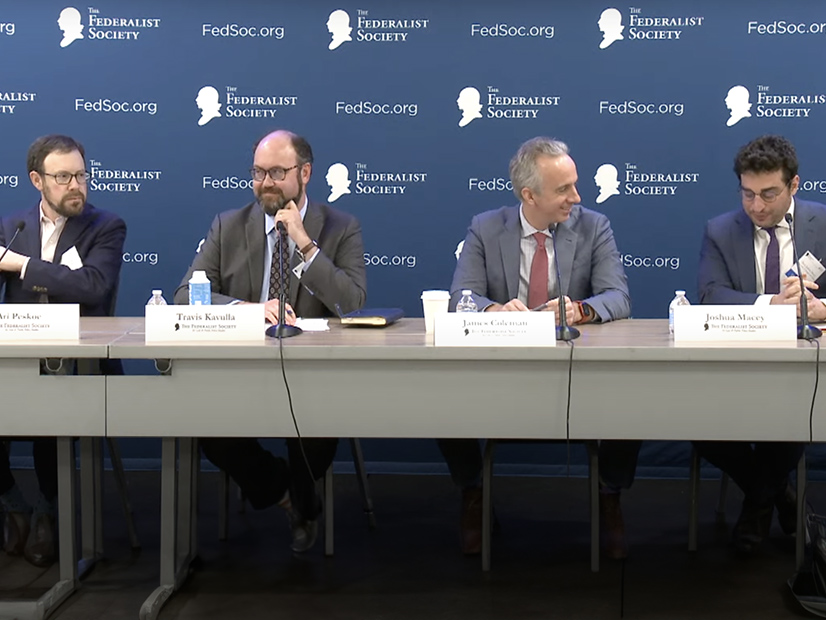
Economic deregulation started out as a Republican policy, but GOP appointees to FERC have been questioning how it has been applied to the electric industry, a trend that was explored Jan. 5 at the 25th Annual Federalist Society Faculty Conference in D.C.
Economic deregulation started out as a Republican policy, but GOP appointees to FERC have been questioning how it has been applied to the electric industry, a trend that was explored Jan. 5 at the 25th Annual Federalist Society Faculty Conference in D.C.
James Coleman, a professor at the Southern Methodist University Dedman School of Law, noted that former Commissioner Bernard McNamee has said marginal price auctions for energy are not ensuring reliability and that former Commissioner James Danly has said the markets are not a statutory requirement and that vertically integrated states have cheaper prices.
FERC Commissioner Mark Christie has not gone as far in his criticisms, but he has argued in the Energy Law Journal that it is time to examine whether the basic RTO market model is the best way forward, Coleman said. (See FERC’s Christie Calls for Reassessment of Single Clearing Price.)
“In some ways, it’s not so different from the traditional critique that we’ve seen from progressives of the use of electricity markets in providing electricity, which is they have been concerned that those electricity markets give short shrift to some of the important concerns other than price,” Coleman said.
Critiques from the left have focused on how the markets favor prices over environmental impacts, especially climate change, but the emerging criticism from the right is focused on how markets are impacted by a growing share of subsidized renewable power, Coleman said.
“In both the case of progressive critiques, and in the case of these increasing conservative critiques, the real concern is less about the use of markets, but more about what kinds of regulations we’re using to drive the kind of preferred energy sources,” he added.
One conservative critique is that the markets are focused on short-term costs and thus have no long-term vision, said Ari Peskoe, director of Harvard Law School’s Electricity Law Initiative. That led to the Trump administration trying to stem the shift from coal and nuclear to natural gas with a proposal that would have paid such baseload power plants outside of the ISO/RTO markets, effectively ending them.
“To maintain reliability, Scott Pruitt, who was then the head of EPA, went on TV and claimed that we needed to have 30% coal in our electricity mix, because, for the first time, coal was suddenly dropping below this marker,” Peskoe said. “And, so, he fabricated this number that was necessary to keep the system reliable.”
The so-called Grid Resiliency Pricing Rule, proposed by the Department of Energy, was rejected by FERC. Peskoe noted that the only utility to publicly support the rule was FirstEnergy, which was later found to be bribing Ohio officials for favorable treatment of its coal and nuclear plants in a massive corruption scandal.
Texas went further with restructuring than any other market, including on the retail side, and the devastating blackouts it experienced from Winter Storm Uri in February 2021 led to additional arguments against markets’ ability to maintain reliability.
“Texas is sort of vaunted as a purely competitive power market. It presents an interesting experiment, because there are actually a handful of remaining utility monopolies within the Texas ERCOT footprint that have no consumer choice, and which own their own fleet of power generation,” NRG Energy Vice President of Regulatory Affairs Travis Kavulla said. “And those power plants make their revenue by recourse to this captive base of ratepayers.”
Those traditionally regulated firms had poorer performance among their fossil fuel-fired power plants than did the competitive firms such as NRG, he added. The competitive market also was unable to pass along the huge costs from the storm, whereas Kavulla cited one gas utility in Oklahoma that is charging its customers $7/month for several decades to cover its costs from a week’s worth of natural gas.
The market felt major impacts from the storm, with Kavulla citing one NRG trader who had a retail deal exposed to wholesale prices and wound up spending $55 to boil a pot of water for tea that week. But instead of passing the costs along to customers for the next 20 years, NRG lost about $1 billion purchasing replacement power.
Uri also exposed issues with the side of the industry that has never seen any kind of deregulation — the distribution system — and how to implement rolling blackouts, Peskoe said. Utilities were not aware of vital natural gas infrastructure that needed power to keep operating, so when they cut off electricity to such sites, they only made the gas shortage worse, he added.
Winter Storm Elliott in late 2022 also showed that vertically integrated states can have some of the same issues, he said.
“It comes back to standards, sort of more traditional forms of regulation, because this is an essential good that people need,” Peskoe said. “And so, market or nonmarket is only sort of part of the debate; we have to have all this stuff happening to support the market or non-market and make sure that that all runs smoothly.”

